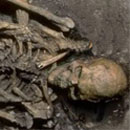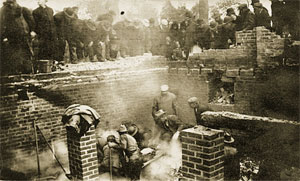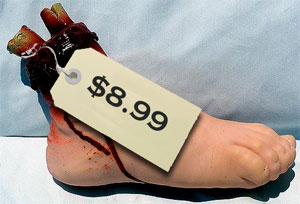The 6 Most Horrifying Ways Anyone Ever Got Rich

Some people will do anything for money. And we mean freaking anything.
We're telling you right now, this is not for those with weak stomachs or a generally positive view of humanity. Because sometimes when there's a paycheck on the line, people will do things that would make Eli Roth puke.
Belle Gunness Torches Her Way to Riches

The key to life is to turn your failures into successes. Just ask Bell Gunness, who managed to succeed despite a series of devastating fires. Granted, she started the fires, but we like to think the point still stands.
Belle Gunness emigrated from Norway to the USA in 1881. She quickly married and set up a candy store that failed to make any money. One year later it burned to the ground but, fortunately, it was insured. She used the money to buy a house in Austin. In 1898, it burned to the ground. Thankfully, it also was insured. In 1900, her husband, Max Sorenson, burned to the grou- oh, no, he died. He had, though, just taken out two insurance policies.
Belle used the money to buy a farm in La Porte, Indiana. Soon after moving in, the boat and carriage house burned to the ground. You see a pattern emerging here?

In 1902, Belle's second husband, Peter Gunness died (when a large sausage grinding machine "accidentally" fell on him). Belle, who had the world's most trusting insurance company, got paid on her claim for $3,000.
Needing a good man to accompany her through all of life's troubles and mysterious fires, Belle sent advertisements to Norwegian language papers asking for a mate. Over the next two years a number of suitors turned up at Belle's farm, took out life insurance policies, and promptly disappeared.
Finally on April 28, 1908, in the aftermath of yet another fire at the Gunness farm, police found four bodies in the basement; one adult and three children. The adult was thought to be Belle, but was hard to identify because the head was missing.

Authorities, finding this whole scene slightly suspicious, began digging up Belle's back yard. They found the remains of 12 bodies and numerous body parts. They never found Belle's head, despite the best efforts of her insurance company's agents who probably just wanted to give it a check.
How Much Did She Make?
It is estimated Belle made $30,000 from the various husbands who got sucked in by the newspaper ad, and maybe as much as $250,000 overall. It sounds impressive, but considering the sheer number of bodies she left in her path, we think it works out to like, six dollars per victim.
Burke and Hare Sell Their Bodies (Well, Not Theirs)

William Burke and William Hare set out to make their money in the same fashion as any young up and coming entrepreneur living in 19th century Britain: by stealing dead bodies for dissection.
A pretty gruesome way to make a living, sure. But such was the demand for corpses (for medical students to practice on) that it was a pretty popular crime and one generally overlooked by the authorities, since the victims were already dead and all. Burke and Hare made their first buck from the trade when a tenant in Hare's lodging house died. They took the body and sold it to Edinburgh Medical College for seven pounds.
It didn't take long before the pair started thinking about how they could make their operation more productive. The two thought outside of the box. You know, the box people were buried in. That's right, these savvy young lads cut out the middle man and just started killing people on their own.

"I gotta tell you, this is so much easier than digging up graves.
Over 18 months, Burke and Hare, along with their wives, killed 16 people. First they killed their tenants, then, when their supply ran out, they started luring people to the apartment.
Unfortunately for the pair, one of Hare's tenants became suspicious after finding a dead body under a bed and alerted the police. Hare was given immunity from prosecution in exchange for testimony against Burke. As a result Burke was hanged in 1829, his body given to medical students to dissect according the British rules of ironic punishment.

How Much Did They Make?
At the rate these guys were going, it seems like they'd have had to slaughter a whole city to make a decent living. Burke kept a diary about the murders and wrote in one entry: "July 1. Sold the Englishman for L10. Kept the whole money, for Hare's conduct to me."
So these jackasses killed 16 people that we know about, yet still haggled over a few bucks here and there. It almost seems like they could have, you know, just gotten jobs instead.
Marcus Licinius Crassus: Fire Fighter for Profit

Marcus Licinius Crassus was a Roman general and politician who commanded his legions around 70 BC. He's credited with creating the first fire brigade, though he probably wasn't thought of as highly of as FDNY since his primary motivation for putting out fires was to extort money from the property owners.
It all began when Crassus noticed the tendency of buildings in Rome to burn down, due to being built too high and close together and with large wooden support beams. To capitalize on this, he bought 500 slaves and put together a fire brigade. Then, he'd show up at the scene of the fire and make the owner a deal. It went something like this:
"Sell me your building, or I'll let it burn down along with everything you own. I'll give you 30 Talents."
"Ah come on Crassus, I bought it for 72 Talents. And I added that deck!"
"20 Talents for the house pal."
"I'll take 80. 80 Talents." (Noise of building collapsing in on itself)
"10 Talents bud. Time's running out. You take it or you get nothing."

"Yeah, I smell the fire, but I'm not even turning around until you show me some money. Tick tock."
It was kind of like how a fire department would work under the Libertarians. Not only would Crassus buy the house that was burning down, he'd buy the neighbouring houses that were at risk of catching fire. He'd then set the slaves to work putting out the blaze and rebuild any damaged houses, to be sold later at an enormous profit.
How Much Did He Make?
Crassus eventually amassed a fortune almost equal to that of the annual income of the Roman Treasury. He accumulated over 7,100 talents, or 200 million Sestertii. We have no idea what either of those things are but we do know he's listed as one of the 10 richest men in history.

Later Crassus went off to war in Parthia (modern day Iran). His soldiers demanded he parley with the Parthians who had offered to meet him. At the meeting Crassus was seized, tortured and had molten silver poured down his throat to sate his thirst for wealth.
And that, Mr. Obama, is why you don't negotiate with Iran.
The People of Vernon, Florida Mutilate Themselves for Profit

Why did more than two-thirds of all loss-of-limb accident claims in the United States in the late '50s and early '60s come from the Florida Panhandle? Well, in the words of John J. Healy, insurance investigator, "Vernon's second-largest occupation was watching hound dogs mating in the town square, its largest was self-mutilation for monetary gain."
Yep, the good townsfolk of Vernon were deliberately maiming themselves in order to claim insurance policies they'd taken out on their limbs. Nearly 50 people in Vernon (population 780) had some kind of horrific "accident".
L.W. Burdeshaw, an insurance agent, told the St. Petersburg Times in 1982 that his list of policyholders included a man who sawed off his left hand at work, a man who shot off his foot while protecting chickens, a man who lost his hand while supposedly trying to shoot a hawk, a man who somehow lost two limbs in an accident involving a rifle and a tractor, and a man who bought a policy and then, less than 12 hours later, shot off his foot while aiming at a squirrel.

Insurance agents, probably disillusioned by the whole Belle Gunness affair, were a little suspicious. Cutting your hand at work may be possible. Sawing off your entire hand at work really takes some amount of sustained effort. But that the kind of can-do attitude that marks the people of Vernon (besides a disturbing lack of symmetry).
These people either had enormous balls, or they really, really needed the fucking money.
How Much Did They Make?
No one in the town was ever convicted of fraud, and it's not easy to find out just how much they got away with. What we know is that one farmer took out policies with 38 different companies before, in some no doubt comical accident, he lost his left foot.
Luckily, the particular day of the "accident" he happened to be driving his wife's automatic, since if he'd been driving his own stick shift he would have needed the left foot to use the clutch. He also happened to have a tourniquet in his pocket (in case of snake bites, he insisted). He could be telling the truth, right?

For snakes?
Well, it turned out he'd taken out so much insurance that he was paying premiums that cost more than his total income. He collected more than $1 million from all the companies.
The insurance companies fought it but conceded, "it was hard to make a jury believe a man would shoot off his own foot." Proof once again that there is good money to be made by being just a little crazier than the world thinks possible.
H.H. Holmes

You know what makes a bad combination? Medical degrees and murderous insanity.
And so we have H.H. Holmes, who graduated in medicine from the University of Michigan in 1884. He was a likable man, handsome, friendly and charming. In the late 1880s, to seek his fortune, he moved to Chicago and took a job in a pharmacy. A nice man all around, you might think. But only if you were retarded and completely skipped the rest of this article.
By 1888 Holmes had murdered his boss and stolen her drugstore (telling friends she was "in California"). The key to a good business, though, is expansion, so he bought up a vacant lot on the other side of the street and built a large hotel.
Well, it wasn't really a "hotel," except in the sense the Hotel California was a hotel. You can check out anytime you like, but you can never leave. Except you can't check out. Because you're dead. Or slowly suffocating in an airtight vault, or being stretched on a rack in the basement that Holmes used to see how far the human body could stretch (Answer: not that far).

In retrospect, it's nothing like Hotel California.
And that's just the basement. The building was designed to Holmes' specific instructions to create a labyrinth with secret chambers, trap doors, sliding walls, hidden laboratories and torture rooms. We'd think the contractors would have asked a few questions, but some people don't like to pry.
But Holmes didn't design all that just for fun. Like everyone on this list, he was a businessman. Once a guest at the hotel had been killed, Holmes would take them to the basement, strip them of their flesh, craft them into skeleton models and then sell them to medical schools.
Holmes left his hotel after 1893 due to a lack of guests, possibly because the Chicago World's Fair had ended, possibly because he'd killed everyone in Chicago. He then moved to Philadelphia and promptly murdered his business partner, to collect on a $10,000 insurance policy.
Actually, "Murdered," isn't really descriptive enough. We'll let Holmes himself tell you about it:
"I proceeded to burn him alive by saturating his clothing and his face with benzene and igniting it with a match. So horrible was this torture that in writing of it I have been tempted to attribute his death to some humane means-not with a wish to spare myself, but because I fear that it will not be believed that one could be so heartless and depraved."
Holmes then went on the run, taking with him, for some reason, Pitezel's three children. Guess what happened to them?
Holmes was arrested for the murder of Pitezel and his three children, and hanged. The only official number of victims is 27, though it's thought the real number is a lot higher, probably around the death toll of a Michael Bay film.

How Much Did He Make?
The reason it's so hard to pin down the number of Holmes' victims is because he was a pathological liar, on top of everything else. So who knows how much cash he collected from his carnival of horrors. What we do know is that he kept turning a profit right up until the end, when he sold his confession to the Philadelphia Inquirer for $10,000.
Dr Marcel Petiot, The Anti-Schindler

It's January 1942, Nazi occupied France. There is a small time con man named Dr. Marcel Petiot, who moved to Paris and set up a medical practice, claiming to have been an intern at a mental hospital. That was pretty close to the truth. He had been a patient there.
Thanks to his well-rounded experience of having seen a mental health facility from both sides of a straight jacket, Petiot spent his time selling addictive narcotics and conducting the occasional illegal abortion. When World War 2 and the Holocaust came along, Petiot saw his opportunity to make some extra cash on the side.
The Nazis were on the hunt for Jews to send off to concentration camps. Petiot put out word that he'd help fugitive Jews escape from the country, for a fee of 25,000 Francs per person. We know what you're thinking. Sure, the guy charged an arm and a leg. But in the end, he was doing good, right? He was lining his pockets, but saving lives at the same time!

Where did he get all those suitcases?
You might want to stop reading now, so you can keep believing that.
When customers came to Petiot, he told them that in order to enter Argentina (their alleged destination) they had to be inoculated. He would stick them with a needle and...
On March 6, 1944, the police arrived at Petiot's burning three story house. Once inside, they found a large heap of quicklime mixed with human remains. There was a pit dug in the stable, full of quicklime and corpses in various stages of decomposition. They found basement sinks large enough for draining corpses and a soundproof octagonal chamber with wall-mounted shackles and a peephole in its door. On the staircase leading to the basement, police found a sack containing a headless corpse, missing its organs.
Petiot was later arrested and during the trial, maintained that the whole thing was a big, wacky misunderstanding. They didn't buy it, and Petiot was beheaded.

How Much Did He Make?
Petiot not only would collect on his huge fee, but would take all of the victim's possessions (they were fugitives, so would come to him with all of their life savings on them). Authorities say Petiot's haul ran up to--holy shit--200 million Francs.
The lesson? Crime doesn't pay, but apparently unfathomably dark, monstrous evil pays quite well.
If you're ready for something totally different from that, to restore your faith in mankind, check out Third Reich to Fortune 500: Five Popular Brands the Nazis Gave Us.